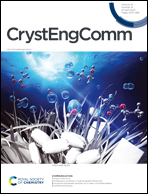Controlled synthesis of twinning β-form anhydrous guanine nanoplatelets in aqueous solution†
Abstract
Biogenic twinning β-phase anhydrous guanine nanoplatelets are utilized as optical materials in organisms. However, it is still a puzzle how to produce crystalline guanine platelets in aqueous solutions since guanine has a low solubility in water. Herein, the controlled synthesis of twinning guanine nanoplatelets was realized for the first time in an aqueous solution in the presence of poly(1-vinylpyrrolidone-co-vinyl-acetate) via ammonia volatilization. The synthesized rectangular twinning guanine nanoplatelets with an exposed (100) face were β-form anhydrous guanine (β-AG), and the twinning angle of the two c-axes was about 83°, similar to the biogenic twinning β-AG nanoplatelets. The length and thickness of the twinning β-AG nanoplatelets were about 2 μm and 42 ± 3 nm, respectively. There were about five to seven layers observed for the synthesized twinning β-AG nanoplatelets, with each layer being as thin as 6 ± 2 nm. It was proposed that amorphous guanine particles are formed as intermediate precursors, which dissolve and recrystallize to single-crystalline β-AG nanoplatelets, and then multilayered twinning β-AG nanoplatelets are formed via π–π interaction with the assistance of the guanine-quartet assembly. The obtained twinning β-AG exhibited a high reflection intensity in the visible and near infrared region and a brilliant pearlescent luster, indicating that they could potentially be applied as optical materials. This work provides a new design strategy to synthesize particular organic molecular crystals with low solubility in water and a novel formation mechanism for twinning organic crystals.



 Please wait while we load your content...
Please wait while we load your content...